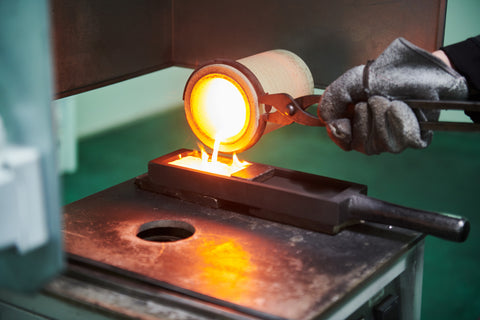Choosing the Right Melting Furnace for Gold: A Comprehensive Guide
Gold, known for its intrinsic value and timeless beauty, has been treasured by civilizations for centuries. Whether you are a jewelry maker, a hobbyist, or a professional goldsmith, having the right melting furnace is crucial for working with this precious metal.
With so many options available in the market, it can be overwhelming to determine which melting furnace is the best fit for your needs. In this comprehensive guide, we will explore the key factors to consider when choosing a melting furnace for gold.
1. Type of Melting Furnace:
There are several types of melting furnaces available, each with its own advantages and limitations. The most common types include electric, propane, and induction furnaces. Electric furnaces are easy to use and offer precise temperature control, making them suitable for small-scale operations. Propane furnaces, on the other hand, are portable and ideal for outdoor use. Induction furnaces are known for their efficiency and ability to rapidly heat metals, making them suitable for large-scale operations.
2. Melting Capacity:
Consider the volume of gold you will be working with to determine the melting capacity you require. If you are a hobbyist or working on small projects, a furnace with a lower melting capacity will suffice. However, if you are a professional goldsmith or running a jewelry-making business, investing in a furnace with a higher melting capacity will ensure you can handle larger quantities of gold efficiently.
3. Temperature Range:
Gold has a relatively low melting point of 1,064 degrees Celsius (1,947 degrees Fahrenheit). Therefore, it is important to choose a melting furnace that can reach and maintain the required temperature. Look for furnaces that offer a wide temperature range and precise temperature control to ensure accurate melting and casting of gold.
4. Energy Efficiency:
When selecting a melting furnace, consider its energy efficiency. Look for furnaces that are designed to minimize energy consumption and maximize heat transfer. Energy-efficient furnaces not only save you money on operating costs but also contribute to a more sustainable and eco-friendly workspace.
5. Safety Features:
Working with high temperatures and melting gold requires utmost caution. Choose a melting furnace that comes with essential safety features such as temperature control, overheating protection, and safety switches. These features will help prevent accidents and ensure a safe working environment.
6. Durability and Construction:
Investing in a durable and sturdy melting furnace is essential for long-term use. Look for furnaces made from high-quality materials such as stainless steel or ceramic, as they are more resistant to corrosion and can withstand the high temperatures required for melting gold. Additionally, consider the overall construction of the furnace, including the insulation and heating elements, to ensure optimal performance and longevity.
7. Additional Features:
Depending on your specific needs, consider any additional features that may enhance your melting process. Some furnaces come with digital displays, programmable settings, or automatic timers, which can simplify operations and improve efficiency. Assess your requirements and choose a furnace that offers the features that align with your workflow.
8. Budget:
Lastly, consider your budget when selecting a melting furnace. Prices can vary significantly based on the type, capacity, and features of the furnace. While it is important to invest in a high-quality furnace, make sure it falls within your budgetary constraints. Consider the long-term value and benefits the furnace will provide to make an informed decision.
Conclusion
Choosing the right melting furnace for gold is essential for efficient and accurate gold melting and casting. By considering factors such as the type of furnace, melting capacity, temperature range, energy efficiency, safety features, durability, additional features, and budget, you can make an informed decision that suits your specific requirements. Remember, investing in a high-quality melting furnace will not only enhance your gold-working capabilities but also contribute to your overall success as a goldsmith or jewelry maker.
FAQs
1. What factors should I consider when choosing a melting furnace for gold?
- When choosing a melting furnace for gold, you should consider factors such as the type of gold you are working with (e.g., jewelry, bullion), the desired melting capacity, temperature control options, energy efficiency, and safety features.
2. What are the different types of melting furnaces available for melting gold?
- There are several types of melting furnaces available for melting gold, including electric induction furnaces, propane furnaces, and torch melting furnaces. Each type has its own advantages and considerations, so it's important to choose one that suits your specific needs.
3. How do I determine the appropriate melting capacity for my gold melting furnace?
- The appropriate melting capacity for your gold melting furnace depends on the volume of gold you plan to melt at a time. Consider factors such as the frequency of melting and the size of your gold pieces to determine the suitable melting capacity for your needs.
4. What temperature control options should I look for in a gold melting furnace?
- Temperature control is crucial when melting gold, as precise temperature control ensures optimal results. Look for a melting furnace that offers accurate temperature control mechanisms, such as digital temperature displays and adjustable temperature settings, to ensure you can achieve and maintain the desired melting temperature.
5. What safety features should I prioritize when choosing a gold melting furnace?
- Safety should always be a top priority when working with melting furnaces for gold. Look for safety features such as overheating protection, automatic shut-off systems, and durable construction to ensure safe and reliable operation. Additionally, consider any specific safety requirements or regulations in your area that may influence your choice of furnace.



Leave a comment